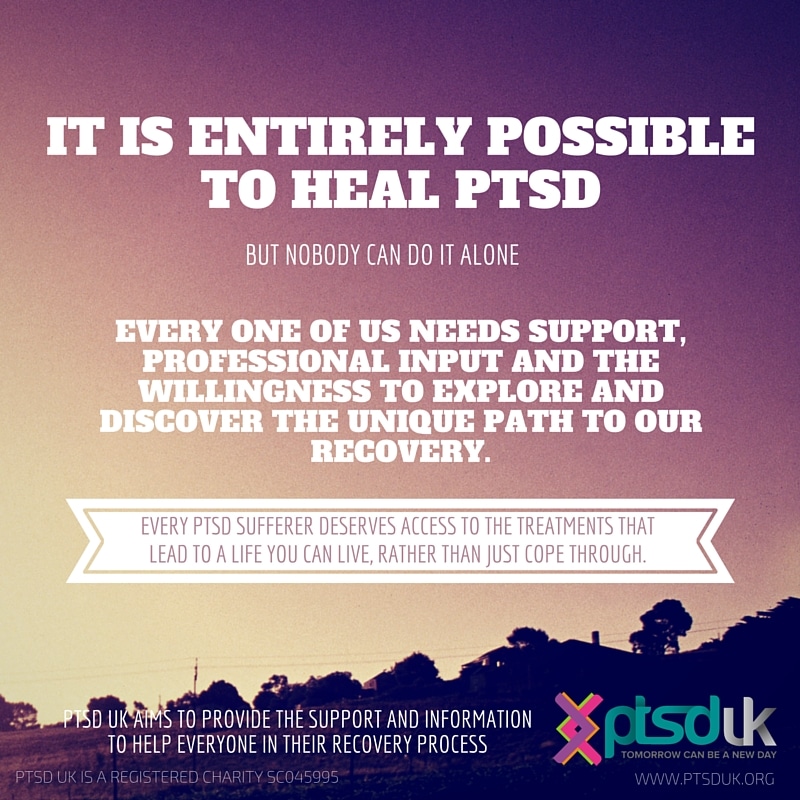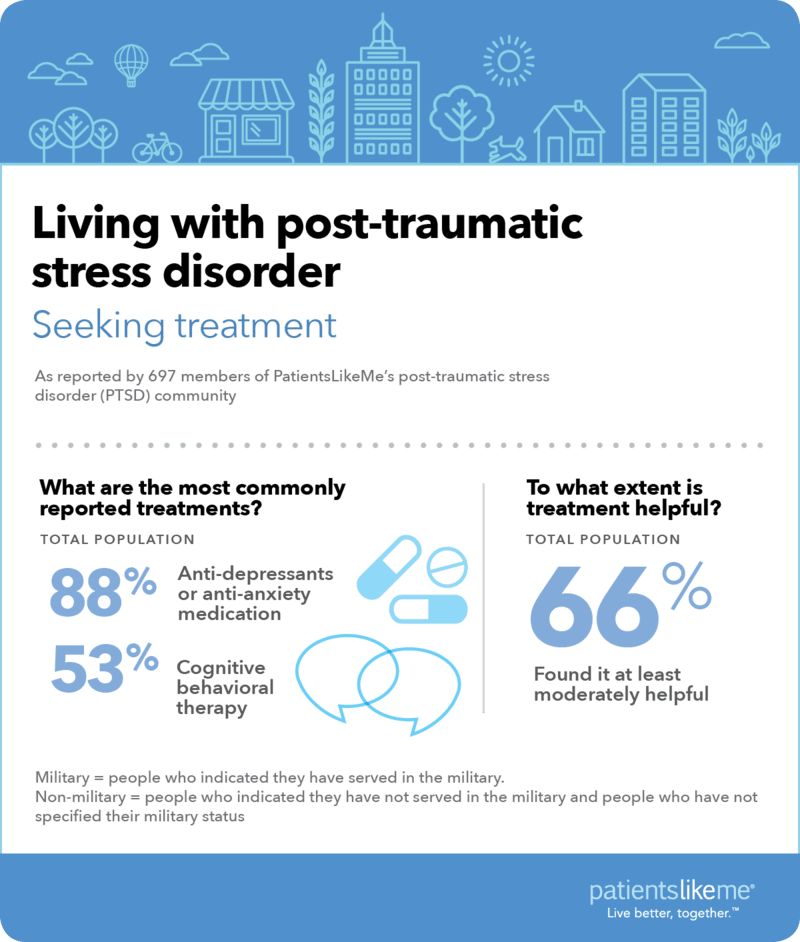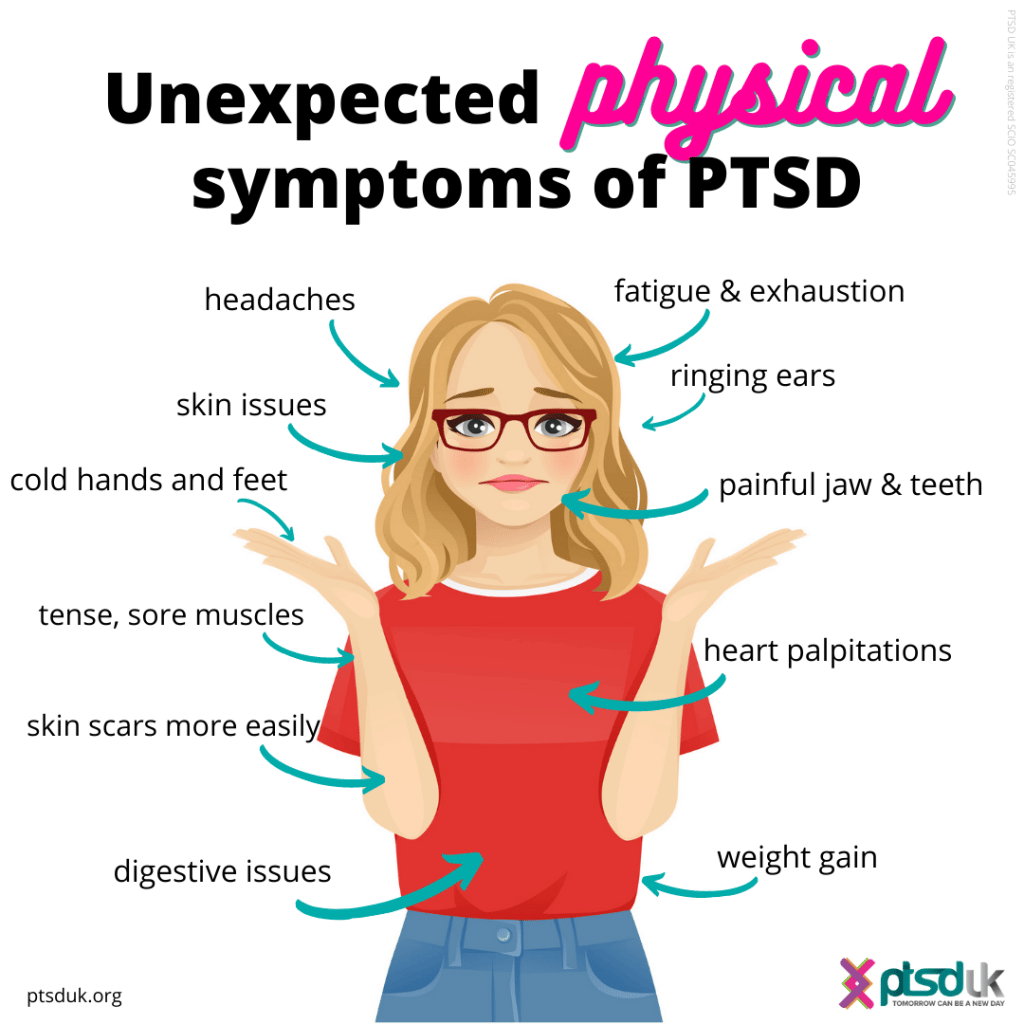Ptsd Treatment And Therapy
Treatment for PTSD can relieve symptoms by helping you deal with the trauma youve experienced. A doctor or therapist will encourage you to recall and process the emotions you felt during the original event in order to reduce the powerful hold the memory has on your life.
During treatment, youll also explore your thoughts and feelings about the trauma, work through feelings of guilt and mistrust, learn how to cope with intrusive memories, and address the problems PTSD has caused in your life and relationships.
The types of treatment available for PTSD include:
Trauma-focused cognitive-behavioral therapy involves gradually exposing yourself to feelings and situations that remind you of the trauma, and replacing distorted and irrational thoughts about the experience with a more balanced picture.
Family therapy can help your loved ones understand what youre going through and help you work through relationship problems together as a family.
Medication is sometimes prescribed to people with PTSD to relieve secondary symptoms of depression or anxiety, although they do not treat the causes of PTSD.
EMDR incorporates elements of cognitive-behavioral therapy with eye movements or other forms of rhythmic, left-right stimulation, such as hand taps or sounds. EMDR therapy techniques work by unfreezing the brains information processing system, which is interrupted in times of extreme stress.
Ptsd Symptoms In Children
In children especially very young children the symptoms of PTSD can differ from those of adults and may include:
- Fear of being separated from their parent.
- Losing previously-acquired skills .
- Sleep problems and nightmares.
- Somber, compulsive play in which themes or aspects of the trauma are repeated.
- New phobias and anxieties that seem unrelated to the trauma .
- Acting out the trauma through play, stories, or drawings.
- Aches and pains with no apparent cause.
- Irritability and aggression.
Do you have PTSD?
If you answer yes to three or more of the questions below, you may have PTSD and its worthwhile to visit a qualified mental health professional.
Beyond Treatment: How Can I Help Myself
It may be very hard to take that first step to help yourself. It is important to realize that although it may take some time, with treatment, you can get better. If you are unsure where to go for help, ask your family doctor. You can also check NIMH’s Help for Mental Illnesses page or search online for mental health providers, social services, hotlines, or physicians for phone numbers and addresses. An emergency room doctor can also provide temporary help and can tell you where and how to get further help.
To help yourself while in treatment:
- Talk with your doctor about treatment options
- Engage in mild physical activity or exercise to help reduce stress
- Set realistic goals for yourself
- Break up large tasks into small ones, set some priorities, and do what you can as you can
- Try to spend time with other people, and confide in a trusted friend or relative. Tell others about things that may trigger symptoms.
- Expect your symptoms to improve gradually, not immediately
- Identify and seek out comforting situations, places, and people
Caring for yourself and others is especially important when large numbers of people are exposed to traumatic events .
Don’t Miss: What Kind Of Disability Is Autism
Ptsd Can Be Treatedyes Theres Hope
If you are overwhelmed by symptoms or negative thoughts that you suspect are related to PTSD, you should contact your health care team to discuss the possibility of a PTSD diagnosis. You can also contact a local mental health facility, like McLean, to get the help you need. You dont have to struggle on your ownthere is a path to recovery.
If you recognize the symptoms in a friend or loved one, you should always reach out to them and offer support. Whether they accept your help or not, knowing that youve offered can be incredibly helpful to those who are affected by mental illness.
Does Ptsd Ever Go Away

Like most mental health conditions, the intensity and duration of PTSD depend on several different factors, including the type and severity of trauma that a patient experiences, how long that trauma lasted, how the patients brain was affected by the trauma, and how receptive the patient is to treatment.
Although the Department of Veteran Affairs reports that 53% of people with PTSD who receive trauma-focused therapy and 42% who receive SSRI and SNRI medications will no longer have PTSD symptoms after 3 months of treatment, lingering effects can and do remain even after treatment.
The symptoms of PTSD really never go away, Dr. Sanjay Gupta told CNN. Here is why: There is a profound psychological and physiological reaction to something traumatic. That traumatic event cant be completely undone, though it can be diminished in the mind.
So, does PTSD ever go away? No, but with effective evidence-based treatment, symptoms can be managed well and can remain dormant for years, even decades. But because the trauma that evokes the symptoms will never go away, there is a possibility for those symptoms to be triggered again in the future. With that said, living and thriving with PTSD is more than possible.
Experiencing trauma does not have to take over your life. The PCH PTSD treatment program will help. We want to know what happened to you, not whats wrong with you. Reach out to a member of our staff at 1-888-525-2140 to begin that conversation.
You May Like: United States Department Of Veterans Affairs Locations
Ptsd In Military Veterans
For all too many veterans, returning from military service means coping with symptoms of PTSD. You may have a hard time readjusting to life out of the military. Or you may constantly feel on edge, emotionally numb and disconnected, or close to panicking or exploding. But its important to know that youre not alone and there are plenty of ways you can deal with nightmares and flashbacks, cope with feelings of depression, anxiety or guilt, and regain your sense of control.
Tip : Anticipate And Manage Triggers
A trigger is anythinga person, place, thing, or situationthat reminds your loved one of the trauma and sets off a PTSD symptom, such as a flashback. Sometimes, triggers are obvious. For example, a military veteran might be triggered by seeing his combat buddies or by the loud noises that sound like gunfire. Others may take some time to identify and understand, such as hearing a song that was playing when the traumatic event happened, for example, so now that song or even others in the same musical genre are triggers. Similarly, triggers dont have to be external. Internal feelings and sensations can also trigger PTSD symptoms.
You May Like: What To Do For Depression And Anxiety
Also Check: Vietnam Veterans Of America Pick Up Donation
Rape Or Sexual Trauma
The trauma of being raped or sexually assaulted can be shattering, leaving you feeling scared, ashamed, and alone, or plagued by nightmares, flashbacks, and other unpleasant memories. But no matter how bad you feel right now, its important to remember that you werent to blame for what happened, and you can regain your sense of safety, trust, and self-worth.
How To Treat Ptsd By Yourself: Using Intention
You cant heal if your focus is scattered. Flashbacks and the fear of relapse along with other PTSD symptoms can make you feel like you’re spinning in a million directions. Reclaiming control means developing your self-empowered healing skills. If you want to know how to treat PTSD by yourself then you’ll like processes that help your brain seek and reach for change.
Creating a healing intention is the first and most important act you can take to get your healing on track. Think about any of the things youve accomplished in your life. From the most mundane task to the most extraordinary achievement, they have all had one common foundational element: You deliberately intended the end result. That is, you were able to visualize what you wanted, figure out the steps it took to get there, and then put that plan into action.
What does this mean? You already possess and are familiar with the necessary skills to figure out how to treat PTSD by yourself as much as possible. Overcoming PTSD requires the same deliberate plan, action, regroup, and follow through as anything else youve done in your life.
Also Check: How To Prove Ibs For Va Disability
Residential Inpatient Ptsd Treatment Centers
If you or a loved one is suffering from post-traumatic stress disorder and wants to seek treatment, residential or inpatient PTSD treatment centers are a solid option. These centers are staffed by trained specialists who can assess your condition and formulate the best treatment plan for you in an atmosphere that is as stress-free as possible.
Read Also: What To Do When Having A Panic Attack
Ptsd Treatment Number One
Based on the research of Dr. James Pennebaker of the University of Texas at Austin, this approach has been found to be effective for easing and alleviating ptsd symptoms for military vets and others dealing with post traumatic stress disorder.
Here are the basic steps to follow:
- Ideally, get a blank journal book specifically for this purpose. If you prefer, you can just use a notepad or your computer.
- This activity needs to be done in private, where there will be no interruptions.
- The journaling process is described here, and it basically consists of writing a detailed account of any and all trauma that you have experienced.
- As much specific detail as possible is very helpful in the writing. You need to write for at least 15 minutes at a time, daily over several weeks, until all of the past trauma is described.
- This gives the “languaging” part of your brain access to the part of your brain that is storing the emotional trauma, providing healing and resolution.
This type of ptsd treatment is not necessarily easy or fast. But then, there’s really nothing easy about ptsd to begin with.
Our goal is to give you some do-it-yourself methods for managing and healing your ptsd symptoms without spending a lot of money or taking strong medications. Here is your chance to become your own best anger management resource.
Read Also: Does Cobra Cover Short Term Disability
Finding A Therapist For Ptsd
When looking for a therapist, seek out mental health professionals who specialize in the treatment of trauma and PTSD. You can ask your doctor or other trauma survivors for a referral, call a local mental health clinic, psychiatric hospital, or counseling center.
Beyond credentials and experience, its important to find a PTSD therapist who makes you feel comfortable and safe. Trust your gut if a therapist doesnt feel right, look for someone else. For therapy to work, you need to feel comfortable and understood.
What Does Ptsd Do To A Person

People with PTSD have intense, disturbing thoughts and feelings related to their experience that last long after the traumatic event has ended. They may relive the event through flashbacks or nightmares they may feel sadness, fear or anger and they may feel detached or estranged from other people.
Read Also: Does Va Disability Stop At Age 65
Children And Young People
Trauma-focused CBT is usually recommended for children and young people with PTSD.
This normally involves a course of 6 to 12 sessions that have been adapted to suit the child’s age, circumstances and level of development.
Where appropriate, treatment includes consulting with and involving the child’s family.
Children who do not respond to trauma-focused CBT may be offered EMDR.
What Are The 5 Signs Of Ptsd
PTSD: Top 5 signs of PTSD you need to know
- A life threatening event. This includes a perceived-to-be life threatening event.
- Internal reminders of a traumatic event. These signs of trauma typically present as nightmares or flashbacks.
- Avoidance of external reminders.
- Changes in mood or thinking.
You May Like: Social Security Office Paducah Kentucky
Moving My Body In Whatever Way Felt Good
Eating well and meditating regularly can make a huge difference, but our bodies also crave exercise. We were designed to move, and when we dont, we cant fully heal. Any kind of exercise helps do what you most love, whether its swimming, working out at the gym, or simply walking in your neighborhood, but incorporate yoga into your weekly routine as well.
Build A Support Network
Having a PTSD support network can also be beneficial for coping with this mental health condition. Having friends, family members, or a coworker who knows about your PTSD and is available to talk can be important for recovery. A PTSD network can be available to listen and offer solutions during difficult times.
Social support has been found to be especially critical for people who have been exposed to multiple traumatic events. One study found that the risk of PTSD was 17 times greater in women who had been subjected to both child abuse and rape, but the severity of PTSD was lower in those who had more social support. Social support can therefore alleviate some of the symptoms associated with trauma.
You May Like: What Do You Do To Get Disability
Develop A Meditation Practice
Monks have practiced mindfulness meditation for thousands of years. Meditation is known to help manage emotions and maintain a calm state of being. It teaches you to pay attention to how youre breathing and what youre thinking.
Being more aware of yourself will help you live in a more relaxed way, eventually learning to recognize PTSD symptoms as they develop. Studies show that meditation, along with other alternative practices such as hypnotherapy, acupuncture, and visualization, can all be beneficial in treating PTSD.
One of my favorite things to encourage my clients to do while they journey through their own healing process is to start a meditation practice. The emotional and neurological benefits of learning how to create your own calm is so therapeutic! A meditation practice can be adapted to your own specific needs, and there is no single right way to do it.
Build A Better Social Connection
Create a bigger social group. This is how to deal with PTSD on your own. Reach out to other people who also have PTSD. Those people will understand you more than those who dont suffer from the condition.
Your family and friends can also be a good source of hope and aspiration. Share your burden with them. In most cases, your family will be the only people who will never leave you whatever happens. Your family could help you recover from your negative experience.
Don’t Miss: How Long Does It Take For Va Disability Back Pay
Exercise And Healthy Diet
The emotional and mental health benefits of regular cardio exercise are well established. PTSD symptoms can be mitigated by adopting a routine for regular workouts, walks, hiking, cycling, runningany physical activity that raises heart rate and releases endorphins. A healthy diet rich in proteins, fresh fruits and vegetables, nuts, and whole grains will also benefit brain health.
Tip : Support Ptsd Treatment With A Healthy Lifestyle

The symptoms of PTSD can be hard on your body so its important to take care of yourself and develop some healthy lifestyle habits.
Take time to relax. Relaxation techniques such as meditation, deep breathing, massage, or yoga can activate the bodys relaxation response and ease symptoms of PTSD.
Avoid alcohol and drugs. When youre struggling with difficult emotions and traumatic memories, you may be tempted to self-medicate with alcohol or drugs. But substance use worsens many symptoms of PTSD, interferes with treatment, and can add to problems in your relationships.
Eata healthy diet. Start your day right with breakfast, and keep your energy up and your mind clear with balanced, nutritious meals throughout the day. Omega-3s play a vital role in emotional health so incorporate foods such as fatty fish, flaxseed, and walnuts into your diet. Limit processed food, fried food, refined starches, and sugars, which can exacerbate mood swings and cause fluctuations in your energy.
Get enough sleep. Sleep deprivation can trigger anger, irritability, and moodiness. Aim for somewhere between 7 to 9 hours of sleep each night. Develop a relaxing bedtime ritual and make your bedroom as quiet, dark, and soothing as possible.
Read Also: What Time Does Disability Get Deposited
Do Children React Differently Than Adults
Children and teens can have extreme reactions to trauma, but some of their symptoms may not be the same as adults. Symptoms sometimes seen in very young children , these symptoms can include:
- Wetting the bed after having learned to use the toilet
- Forgetting how to or being unable to talk
- Acting out the scary event during playtime
- Being unusually clingy with a parent or other adult
Older children and teens are more likely to show symptoms similar to those seen in adults. They may also develop disruptive, disrespectful, or destructive behaviors. Older children and teens may feel guilty for not preventing injury or deaths. They may also have thoughts of revenge.
Taking My Medication As Prescribed
I took the medication that I was prescribed because it allowed me to dip my toes back into the pool of life, and it helped to lift the fog that had been hanging over me. Eventually, I started looking for a different, more sustainable path to healing. Medication provided a bridge and helped me begin to feel better, but in order to fully overcome my PTSD, I needed to take an integrative approach that addressed my mind, body, and spirit. When we care for all parts of ourselves, our healing can be holistic and transformative. For me, it was. By detoxifying my mind and my body through meditation, yoga, and nutrition, I was able to find a long-term solution to deal with my trauma.
Recommended Reading: Veterans Thank You For Your Service
